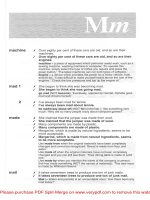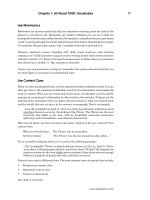Tài liệu Master toefl vocabulary part 2 pdf
Bạn đang xem bản rút gọn của tài liệu. Xem và tải ngay bản đầy đủ của tài liệu tại đây (75.23 KB, 10 trang )
○○○○○○○○○○○○○○○○○○○○○○○○○○○○○○○○○○○○○○○○○○○○○○○○○○○○○○○○○
P
ART I
TOEFL VOCABULARY
○○○○○○○○○○○○○○○○○○○○○○○○○○○○○○○○○○○○○○○○○○○○○○○○○○○○○○○○○○○○○○○○○○○○○○
BASICS
CHAPTER 1 All About TOEFL Vocabulary
01_TOEFL Vocab,Ch1,1-18 8/4/06, 12:281
01_TOEFL Vocab,Ch1,1-18 8/4/06, 12:282
○○○○○○○○○○○○○○○○○○○○○○○○○○○○○○○○○○○○○○○○○○○○○○○○○○○○○○○○○○○○○○○○○○○○○○○
chapter 1
3
All About TOEFL
Vocabulary
OVERVIEW
• Vocabulary on the TOEFL
• Strategies for learning and remembering new words
• Summing it up
VOCABULARY ON THE TOEFL
TOEFL vobabulary questions ask you to identify the meanings of words and phrases
that appear in the reading passages. The words and phrases that are tested are
important to understanding the entire passage, and, for the most part, you will have
to figure out their meanings. On the TOEFL iBT, however, if there are technical or
unusual words in the passage, you will see the definition presented in a box.
STRATEGIES FOR LEARNING AND REMEMBERING NEW
WORDS
Read
Reading is probably the single best way to improve your vocabulary. When you’re
preparing for the TOEFL, read materials that contain the words that you are
most likely to encounter.
Use a Dictionary and Thesaurus
If you’re serious about improving your testworthy vocabulary, you must have
(and use!) a good dictionary. (A good thesaurus also helps a lot, but more on that
later.) A dictionary is an alphabetical reference list of the words in the language.
01_TOEFL Vocab,Ch1,1-18 8/4/06, 12:283
4PART I: TOEFL Vocabulary Basics
○○○○○○○○○○○○○○○○○○○○○○○○○○○○○○○○○○○○○○○○○○○○○○○○○○○○○○○○○○○○○○○
○○○○○○○○○○○○○○○○○○○○○○○○○○○○○○○○○○○○○○○○○○○○○○○○○○○○○○○○○○○○○○○○○○○○○○○○○○○○○○○○○○○○○○○○○○○○○
www.petersons.com
A dictionary entry always includes the following components:
•
Spelling
•
Pronunciation
•
Part(s) of speech
•
Irregular forms of the word
•
Definition
•
Etymology (the derivation and development of words)
An entry may also contain synonyms and antonyms of the word; prefixes, suffixes, and
other elements in word formation; and abbreviations.
Most people think that all dictionaries are the same. After all, all dictionaries are chock
full of words listed in alphabetical order. They all have pronunciation guides, word
definitions, and word histories. However, all dictionaries are not the same. Different
types of dictionaries fit different needs.
For example, dictionaries have been written just for scholars who research the history
of language. The most famous scholarly dictionary is The Oxford English Dictionary. An
unabridged dictionary, the OED (as it’s often called) contains more than 500,000
entries. Don’t rush right out to buy one to stash in your bookcase, however, because the
OED now contains about 60 million words in 20 volumes. If shelf space is an issue and
you simply can’t live without an OED, however, online and CD-ROM versions are
available from www.oed.com.
Dictionaries have been created just for adults, college students, high school students,
and elementary school students, too. The following list includes the bestselling general
dictionaries and the Web addresses for the online versions, when available:
•
The American Heritage Dictionary of the English Language (Houghton Mifflin Co.:
www.bartleby.com/61)
•
Merriam-Webster’s Collegiate Dictionary (Merriam-Webster, Inc.: www.m-w.com/
dictionary.htm)
•
Merriam-Webster’s Pocket Dictionary (Merriam-Webster, Inc.)
•
The New Shorter Oxford English Dictionary (Oxford University Press, Inc.)
•
The Random House College Dictionary (Random House, Inc.)
•
Webster’s New World College Dictionary (Hungry Minds, Inc.)
Which dictionary should you purchase and use? Since more than 30,000 dictionaries are
currently offered for sale online, you’ve got some shopping to do. Here’s what you need:
•
A dictionary that contains all the words that you are likely to encounter on
standardized tests. This will most likely be the same dictionary that you can use
in college, in your personal life, and in your professional life.
01_TOEFL Vocab,Ch1,1-18 8/4/06, 12:284
○○○○○○○○○○○○○○○○○○○○○○○○○○○○○○○○○○○○○○○○○○○○○○○○○○○○○○○○○○○○○○○
○○○○○○○○○○○○○○○○○○○○○○○○○○○○○○○○○○○○○○○○○○○○○○○○○○○○○○○○○○○○○○○○○○○○○○○○○○○○○○○○○○○○○○○○○○○○○
Chapter 1: All About TOEFL Vocabulary 5
www.petersons.com
•
The words explained in terms that you can understand.
•
A size that fits your needs. You might wish to buy a hardbound dictionary to use
at home when you study and a smaller paperback to keep in your backpack or
briefcase for immediate reference.
•
An online dictionary can’t fulfill all your needs, unless you like to tote around your
laptop and fire it up all the time. Always have a print dictionary to use, even if you
have an online version.
When you’re trying to find a word in the dictionary, always begin by making an educated
guess as to its spelling. The odds are in your favor. However, the more spelling patterns
you know for a sound, the better your chances of finding the word quickly. You can find
a pronunciation chart in the beginning of any dictionary. Once you’ve narrowed down
your search and you’re flipping through the pages, use the guide words, located on the
upper-corners of the pages, to guide your search. Then, follow strict alphabetical order.
The following diagram shows how to read a sample entry.
can-dy (kan’de), n. pl. -dies, v., -died, -dying. —n. 1. any
of a variety of confections made with sugar, syrup, etc.
combined with other ingredients. 2. a single piece of such a
confection. —vt: 3. to cook in sugar or syrup, as sweet
potatoes or carrots. 4. to cook in heavy syrup until transpar-
ent, as fruit, fruit peel, or ginger. 5. to reduce (sugar, syrup,
etc.) to a crystalline form, usually by boiling down. vi: to
become candied. see vt. [ME sugre candy candied sugar
< MF sucre candi; candi << Ar qandi or sugar = qand sugar
(< Pers; perh. orig. piece of sugar candy; if so, akin to Skt
khanda piece)]
Let’s look a little closer at the entry:
•
Notice the pronunciation comes right after the entry word. It’s in parentheses—
(kan’de).
•
The part of speech is indicated by the n. It’s an abbreviation for “noun.” Look at the
third entry. The vt: right before the 3. shows that the word can be used as a
transitive verb (a verb that must be followed by a direct object). The vi: at the end
of the fifth entry shows that the word can also be used as an intransitive verb (a verb
that does not need a direct object to make sense in a sentence).
•
The pl. at the beginning of the entry shows how you can make the word plural (more
than one). Here, the singular “candy” becomes the plural “candies.”
spelling,
pronunciation
part of speech
plural
definitions
etymology
(word history)
01_TOEFL Vocab,Ch1,1-18 8/4/06, 12:285









